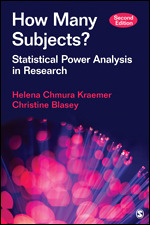How Many Subjects?
Statistical Power Analysis in Research
- Helena Chmura Kraemer - Stanford University (Stanford, California, United States)
- Christine Blasey - Palo Alto University
Meta-Analysis | Quantitative/Statistical Research (General) | Research Methods in Psychology
With increased emphasis on helping readers understand the context in which power calculations are done, this Second Edition introduces a simple technique of statistical power analysis that allows researchers to compute approximate sample sizes and power for a wide range of research designs. Because the same technique is used with only slight modifications for different statistical tests, researchers can then easily compare the sample sizes required by different designs and tests to make cost-effective decisions in planning a study. These comparisons demonstrate important principles of design, measurement, and analysis that are rarely discussed in courses or textbooks, making this book a valuable instructional resource as well as a must-have guide for frequent reference.
"Kraemer and Blasey provide an authoritative and readable introduction into applied statistical power analysis and its application with many common statistical procedures."
“This is a necessary text for anyone conducting research in the real world. Nowhere else will you find a better answer to the question, 'How Many Subjects?'”
Too advanced for the course; but on additional/further readings list.

